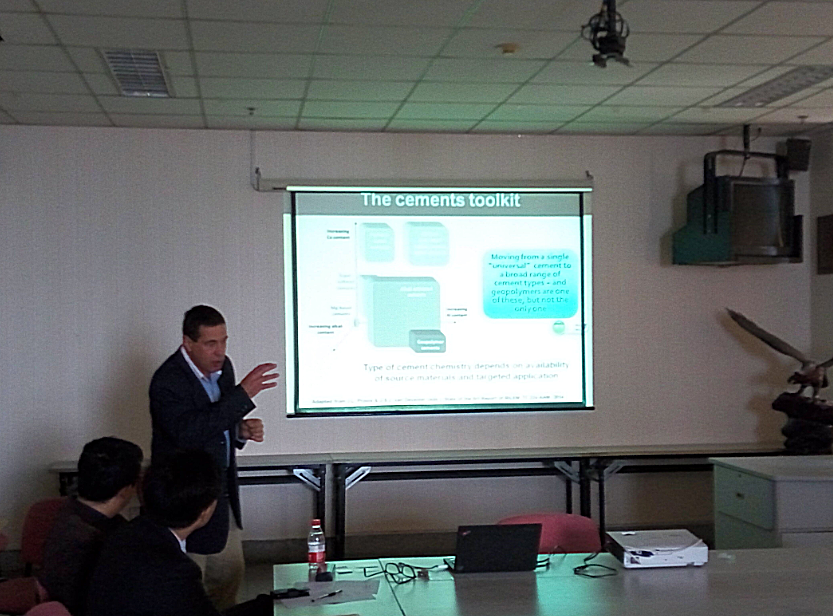4月19日上午,澳大利亚墨尔本大学Jannie Van Deventer教授与蒙纳什大学Wenhui Duan副教授访问我院,并就建筑工业化合作事宜与我院师生开展了广泛深入的交流。院长吴刚、副院长王景全、院长助理张建、刘钊、潘金龙、陈惠苏、朱虹、张永兴、徐照、孙泽阳等多位老师和众多研究生参加了交流会。交流会由院长助理张建主持。
王景全副院长首先致欢迎词并介绍了学院开展建筑工业化研究与应用的情况。随后,Deventer教授做了题为“Chemically Activated Cement from Research to Commercial Application”的报告。不同于波特兰水泥,Deventer教授研发的化学激活水泥(Chemically Activated Cement, CAC)能大幅减少制备过程中的二氧化碳排放,这在全球温室效应大背景下具有重要意义。Deventer教授还详细介绍了如何从凝胶行程、界面传递等微观化学理论来优化CAC混凝土的商业化制备和其耐久性等工程性能研究,并展示了这种新材料在世界各地诸多示范工程中的应用。
接着,我院潘金龙教授和刘钊教授分别报告了高性能纤维增强水泥基复合材料-钢筋混凝土组合构件抗震性能、钢-混凝土组合桥梁等方面的研究情况。徐照老师介绍了由东南大学、清华大学等6所高校,以及中国建筑工程总公司等15家行业领军企业、研究机构共同组建的新型建筑工业化协同创新中心。在讨论会中,Deventer教授、Duan副教授与我院师生就CAC材料本身以及它在新型建筑工业化中的应用前景进行了热烈讨论。讨论中,大家对Deventer教授带来的CAC混凝土绿色环保、节能减排的优点表示了充分肯定,同时也对其在土木工程应用中力学性能的研究提出了有益建议,大家都期待能在新材料与建筑工业化的融合方面进行更进一步的接触与合作。
在讨论会的最后,吴刚院长对Deventer教授的报告和各位老师的讨论进行了总结,表达了和Deventer教授在建筑工业化领域展开深层次合作的期望,并就学术交流、国家协同创新中心的申报、高层次人才的引进等方面的合作模式提出了建议并进行了工作部署,以切实促进我院新型建筑工业化协同创新中心的发展,提升我校土木与材料学科的核心竞争力。

(图/文 陈钊)
Jannie Van Deventer教授简介
Jannie van Deventer was educated in South Africa, where he was Head of Chemical Engineering at the University of Stellenbosch. In 1995 he became Professor of Mineral and Process Engineering at the University of Melbourne. From 2003 to 2007 he served as Dean of Engineering. Since 2010 he is an Honorary Professorial Fellow and continues research into chemically activated cement and mineral processing. Since 2006 Jannie has been the CEO of Zeobond, which is commercialising low CO2 concrete. He previously commercialised computer vision technology in the mineral industry, and continues to be involved in the commercialisation of precious metal extraction processes. His publication record of more than 700 papers includes 295 journal papers. With an h-index of 55 and 10,800 citations Jannie is one of the world’s highest cited researchers in cement and concrete science. He has supervised to completion 30 Master’s and 40 PhD theses. He has received many awards for his research in both mineral processing and concrete science.
报告内容简介
World annual cement production exceeds 4 billion tonnes, making the concrete produced from itthe highest-volume commodity in the world, behind water. Portland Cement (PC) production has a significant environmental penalty of almost one tonne CO2 per tonne cement, and contributes at least 5% of global CO2 emissions. If formulated optimally, chemically activated cement (CAC) made from fly ash, metallurgical slags and natural pozzolans could reduce by at least 80% the CO2 emissions associated with the manufacturing of PC. This paper discusses recent research on the microstructure and gel evolution in these systems and explains how such insight enhances the commercial adoption of these new construction materials.
Significant progress has been made in developing an understanding of the colloid and interface science, gel chemistry, phase formation, reaction kinetics and transport phenomena underlying the chemical activation of calcium aluminosilicates, especially using synchrotron-based analysis in conjunction with advanced computational techniques. Recent thermodynamic modelling has confirmed the existence of stable phases like Al-tobermorite (found in Roman concrete), hydrotalcite and strätlingite in CAC. By using X-ray pair distribution function (PDF) analysis it has been shown that the ordering of calcium aluminium silicate hydrate (C-A-S-H) binding phase in alkali-activated slag can be short compared with the higher extent of ordering in C-A-S-H formed in hydrated PC-slag blends.
In the absence of a long in-service track record, research is required to validate durability testing methods and improve CAC technology. The fact that all concrete standards are based on PC remains an obstacle to the commercial adoption of CAC. Even when asset owners and specifiers such as government, architects and design engineers accept the results of durability testing of CAC, the main barrier to entry of these new materials into an established market is access to a suitable supply of source materials including fly ash, slags and activators. Strategies to overcome these obstacles will be discussed.


